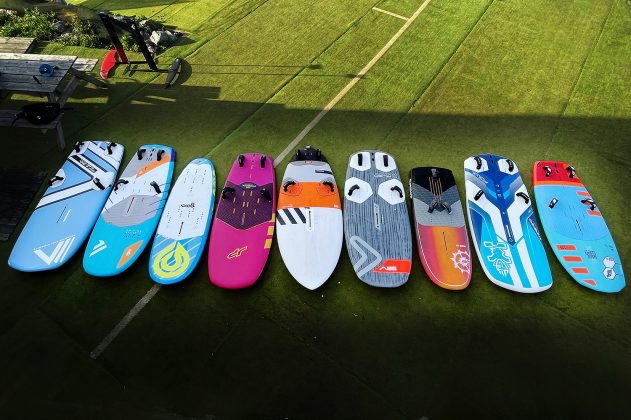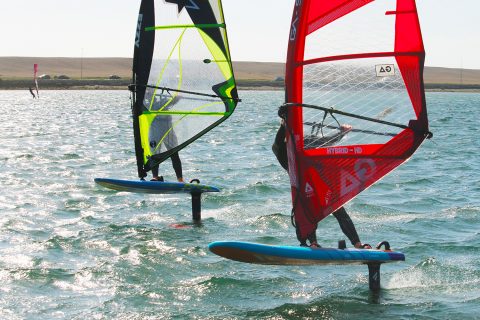WIND FOIL BOARD TEST 2022
The test team get cleared for take-off and fly round Portland Harbour to test some of the latest wind foil board designs.
EDITOR: TRIS BEST // SECOND TESTERS: Joe North, Scott Stallman, Rob York, James Faley.
TEST LOCATION: PORTLAND HARBOUR // PHOTOS TRIS BEST
Foiling, in all its forms, continues to progress at a stunning pace. From its ease and accessibility at entry level to the highest echelons of racing competition, the fevered enthusiasm for flight above the water’s surface amongst all water sports is sustained.
And as can be seen in the diversity of the foiling boards on display in this test, wind foiling very much in the mix. Ranging from manoeuvre-oriented foiling – carving transitions, aerial trickery or even wave riding; to racing at local, national or even international level. Whether you simply like to lock in and cruise over great distances or dabble in lots of different foiling disciplines, there’s a board in this group to suit your desires.
FINDINGS
Despite the diversity of the design briefs amongst this focus group, there seems to be a consensus for board outlines to become more compact. A shorter length means less swing weight and a more active response to pumping the foil. The waterline length of the board and its ability to use this to plane has been overtaken by a need to pump the foil to get going. And once in flight, the shorter more compact planform is undoubtedly more desirable. Mast tracks have been scrutinised in both their position and length. Extra length offers more scope for balancing varying rig sizes, whilst a pattern is emerging amongst several brands to move the track back slightly. As a result, the rig is more upright, improving its power and efficiency, whilst it powers from a more rearward position to engage the foil earlier and improve early lift. To counter this shift, the rider’s stance has then been moved forward, so that it’s easier to get on the front foot and control the flight, thereby increasing the confidence to push. These are all subtle changes, but they make a difference, particularly when foiling at speed.
In the manoeuvres arena, there is not much that can’t be done on a foil, with pioneers pushing the limits in both freestyle and wave riding. They are not disciplines that have necessarily caught fire around the UK’s shores yet, but the tools are there from certain brands and with time spent getting used to them, they’re surprisingly user-friendly and within reach of most with a bit of foiling experience. Their size also makes them the natural crossover platform for winging – a style of hybrid board that has blossomed in recent years. Of the nine boards on test here, over half have consciously been designed for winging too. There are other hybrid options available as well – conventional ‘fin’ windsurfing and SUP foiling, and we’re happy to report that crossover doesn’t mean compromise either. So, think hard about the disciplines you’d like to enjoy and choose wisely.
SUMMARY
The two most directionally focussed boards in the test lineup are the AHD and Starboard. With easily the widest tails, they both like to be loaded with fast efficient foils, yet have inset strap positions and can be tuned for accessibility for the more novice rider. The AHD Compact Foil 83 is light and crisp in nature, while the Foil Freeride 150 is built with durability and environmental impact in mind. The Severne Alien is the purest wind foiling freeride board here, with no crossover even considered in its makeup. Super stable and dependable, it is the easiest board upon which to learn to foil and has plenty of appeal for those that wish for foiling simplicity and cruising comfort. Fanatic’s Stingray Foil and JP’s FreeFoil are incredibly similar in all but name. Both work superbly well as both freeride wind foilers and winging tutors, the Fanatic arguably a little more responsive underfoot, whereas the JP is more dependable and planted. Tabou’s 135 is a fantastic new addition to the Magic Carpet dynasty, its short wide outline providing the stability and response to cater for most rider abilities and demands, albeit its foil box placements make it more foil critical than others on test. The Goya Airbolt Carbon and Slingshot Wizard are the manoeuvre-oriented contenders in the lineup, and whilst the Wizard quotes a significantly larger volume, it undoubtedly takes a little more getting used to, such is its riding style so removed from conventional windsurfing. Invest the time though and the rewards become clear. The Goya is a lively, inspiring yet controllable board and can take your foiling skills to new levels. Both are niche but represent the cutting edge of this foiling avenue. Finally, there’s the RRD Firemove Flight – a standout design that is easy to ridicule and dismiss … until you’ve tried it! If wind-foiling and ‘fin’ windsurfing in the lightest airs is the crossover you’re looking for, this board is well worth the consideration.
All of these boards’ performances are ultimately a sum of various parts (not least the foil) and their setup. If something doesn’t feel right and you can’t figure it out, take advice. Wind foiling has matured well and there’s plenty of good kit out there today, so if it feels awkward, some advice and tuning could make all the difference.
THE LINEUP


